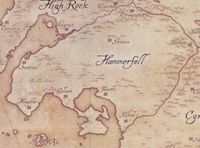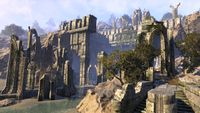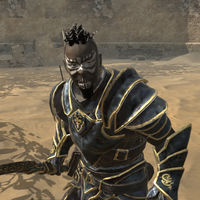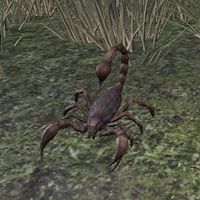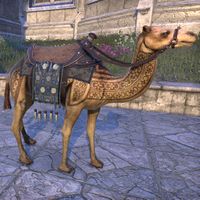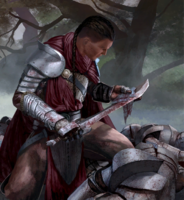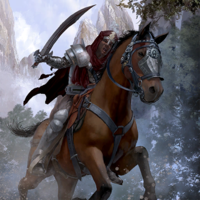Lore:Rihad
| Rihad | |
|---|---|
| Type | Settlement |
| Continent | Tamriel |
| Province | Hammerfell |
| Appears in | Arena |
Rihad is one of the eight major cities in the province of Hammerfell,[1] situated in the southernmost point of the province, near the mouth of the Brena River. Rihad is a port city occupied by the Forebears, the modern-day remnants of the Ra Gada.[2]
Layout and Geography[edit]
Rihad is located in the southern region of Hammerfell, where the Forebears cities are much more cosmopolitan than the traditional Crowns cities to the north.[2] The city itself sits at an ideal spot on the Abecean Coast, next to the Brena River to the south and Hew's Bay to the north. Rihad's region has a tropical wet-dry climate and is prone to the occasional forest fire like their neighbors in Colovia.[3] Not far from the city, just to the south, is an impressive Ayleid ruin called Varlaisvea.[4] Rihad is neighbored by several settlements, including Chaseguard to the northwest, Stonemoor to the northeast, and the Imperial Province to the southeast.[1]
Notable Locales[edit]
History[edit]
Early History[edit]
It is unknown when the city was founded, but the Tavan wave of the Ra Gada have settled along the southern coast of Hammerfell,[6] which is now prominent Forebears country.[2] One of the city's oldest known citizens was the Red Dervish of Rihad, Yousebh the Stringent, who is attributed with the quote, "a daughter of the House of Akos Kasaz shall not marry an infidel of another house." It is a mantra that both the Crowns and Forebears have upheld for many years.[7] Sometime around 1E 2818, the War of Rihad took place between the Redguards and the Colovians. The latter were known to employ Bosmer archers, but realized how undisciplined and prone to desertion they were.[8]
At the time of the Second Empire's occupation of Hammerfell, the Phyllocid Dynasty reigned over a province split apart by the Crowns and Forebears. Prince Ar-Azal of Hegathe inherited a throne rife with conflict and needed a solution to mend the province. After he received a vision from Satakal the World-Eater, who appeared as the Snakehead Potentate, he traveled to the Fresco of the Goshawk and saw that Tava was nested with two mates, instead of the one that is normally there. King Ar-Azal took it as a sign from the divines and married one noblewoman of each faction. He married Fereshtah, daughter of the Forebears Grandee of Sentinel, Ebrahim, and also married Arlimahera, daughter of the Crowns Grandee of Rihad, Murahd.[9]
Rihad in the Third Empire[edit]
Rihad and nearby Taneth were on the path of the Camoran Usurper's invasion of western Tamriel, which started in 3E 249. The Redguards were fully confident that the two cities would have defeated the Usurper, but the Forebears cities were defeated in the Battle of Dragontooth in 3E 253.[10]:8 Refugees from these cities fled north into the Iliac Bay and went as far as Dwynnen.[11] Since the Crowns of Elinhir noticeably did not help the cities to the south, the Forebears of Rihad and Taneth also did not help them in the midst of the War of the Bend'r-mahk years later. They preferred to watch from afar instead of helping them.[2]
During the Imperial Simulacrum in the late Third Era, the city-state of Rihad was an active settlement. It was ruled by Queen Blubamka and had a rivalry with Taneth.[5] After their escape from the Imperial Prisons, the Eternal Champion was set forth on a quest by the spirit of Ria Silmane to retrieve the eight pieces of the Staff of Chaos. The spirit tells the warrior to locate Fang Lair, where the first piece is located.[12]
Their quest eventually took them to the city-state of Rihad, where they garnered an audience with Queen Blubamka. The Queen would have relayed the information, but a band of goblins led by Golthog the Dark stole a special parchment from Rihad Palace. The parchment was able to decipher an Elder Scroll that would in turn reveal Fang Lair's location. The Eternal Champion returned with the parchment from the goblins in Stonekeep and traveled north into Fang Lair, where they found their first piece.[12] Ever since the champion's victory over Jagar Tharn, Imperial-loyalists would retrace their steps across the provinces and make their way through Rihad.[13]
Not much is known about Rihad during the Great War, but what is apparent is that the cities across southern Hammerfell had fallen to the Aldmeri Dominion, with only Hegathe to the west left standing. The entire southern region was left in shambles by the end of the war, even when the Redguards re-claimed the entire region, it was still in a state of ruin. When the White-Gold Concordat was signed in 4E 175, Hammerfell had officially ceded from the Empire,[14] and at that point, the noble house of Rihad faced some issues. Prince Dinahan al-Rihad, an Imperial loyalist was exiled from the throne and later granted asylum in Cyrodiil by the Empire. During his time there, he became an arena combatant and had active intent to retake the throne.[15]
Known Rulers[edit]
The royal family of Rihad is also known as the House of Rihad.[15]
Culture and Society[edit]
The Redguards have been known to make regular contact with the Colovians of western Cyrodiil, especially around the shared borders where towns like Ontus have a mixed population of both. Though most trade occurs through the Abecean Sea, the overland route between Rihad and the trading town on the Brena River; Leftwheal was still important in the mid-Second Era.[16] Colovian Princes sometime hire bodyguards from Rihad.[17]
The Dervishes of Rihad are a faction of talented and religious sword dancers. Sometime in the mid-Second Era, they dueled with the young and adventurous Princess Ayrenn.[18] They shave their camels and tattoo them with mystic symbols so that spirits of the deep desert would not lead them astray.[19]
The Coffee Scorpion of Rihad is named in homage to the city's kaveh, which is considered strong, dark, and sweet.[20] The musk of the local Fennec Fox is turned into a perfume, which is considered very fashionable for the nobility of southern Hammerfell, including Rihad.[21]
Like other cities on the Hammerfell coast, the Redguards of Rihad observe the 20th of Rain's Hand as the Day of Shame. According to legend, the Crimson Ship, a vessel full of Kothringi victims of the Knahaten Flu first left Black Marsh on the 9th of First Seed and was denied refuge from every port on Tamriel. It was later westbound for the Abecean Sea and never seen again. It is said to one day return and the Day of Shame was created in remembrance of that.[10]:7[22]
The Pocket Guide to the Empire, 1st Edition makes it apparent that the people of Rihad like to strip down naked and roll around in the dirt. However, these traits are more attributed to devotees of Satakal, aptly known as the Satakals. They reportedly nip people on the leg like they are snakes and perform exhibitions of "shedding their skin". They also roll on the sands for hundreds of miles, from Balhar to the Nohotogrha Oasis. When the Empire moved onto Hammerfell, they took to the streets and bit at people until they were forced out of the cities by the Provisional Governors.[23]
One of Rihad's most well-known natives from the Third Era was Destri Melarg, who spent much of his life attempting to collect and detail the lost history of the Redguards. He was born during Tiber Septim's reign and moved to the Imperial City when he was nineteen. His ultimate work, Redguards, History and Heroes was never completed, having been published in separate books.[24] In the Fourth Era, Rihad was one of the main ports of the East Empire Company's western lines. It is connected to several cities along the mainland's coast, such as Anvil, Taneth, and Southpoint.[25]
Gallery[edit]
-
Rihad Nomad (Legends)
Notes[edit]
- Arena was originally conceived as a fighting game featuring a tournament that took the player to each of Tamriel's cities to challenge different gladiatorial teams. According to a file from that stage of development left behind in the final game, Rihad's gladiatorial team would have been called "the Bane".[UOL 1]
See Also[edit]
- For game-specific information, see the Arena article.
References[edit]
- ^ a b Map of Hammerfell – The Elder Scrolls: Arena
- ^ a b c d Pocket Guide to the Empire, 3rd Edition: The Ra Gada: Hammerfell — Imperial Geographical Society, 3E 432
- ^ Pocket Guide to the Empire, 1st Edition: Cyrodiil — Imperial Geographical Society, 2E 864
- ^ Varlaisvea Ayleid Ruins in ESO
- ^ a b c d Rihad location and rumors in Arena
- ^ Crafting Motif 28: Ra Gada Style — Lady Cinnabar of Taneth
- ^ A Betrayal of Our Heritage — "Nworc at-Traeh"
- ^ Pocket Guide to the Empire, 1st Edition: Aldmeri Dominion — Imperial Geographical Society, 2E 864
- ^ The Worthy Ar-Azal, His Deeds
- ^ a b The Daggerfall Chronicles — Ronald Wartow
- ^ The Refugees — Geros Albreigh
- ^ a b Fang Lair story quest in Arena
- ^ A Minor Maze
- ^ The Great War — Legate Justianus Quintius
- ^ a b Dinahan-Al-Rihad's dialogue in Blades
- ^ Traveler's Guide to West Weald — Beragon, Imperial Scribe
- ^ Colovian Prince with Bodyguard from Rihad – Pocket Guide to the Empire (1st Edition)
- ^ Ayrenn: The Unforeseen Queen — Headmaster Tanion of the College of Aldmeri Propriety
- ^ Tattooed Shorn Camel mount description text in ESO
- ^ Rihad Coffee Scorpion pet description text in ESO
- ^ Bottle of Fennec Musk Perfume treasure text in ESO
- ^ Day of Shame holiday description in Daggerfall
- ^ Pocket Guide to the Empire, 1st Edition: Hammerfell — Imperial Geographical Society, 2E 864
- ^ Notes For Redguard History — Destri Melarg
- ^ Map of the East Empire Company – The Elder Scrolls V: Skyrim
Note: The following references are considered to be unofficial sources. They are included to round off this article and may not be authoritative or conclusive.

